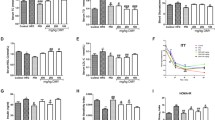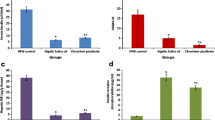Abstract
Indole glucosinolates, present in cruciferous vegetables have been investigated for their putative pharmacological properties. The current study was designed to analyse whether the treatment of the indole glucosinolates—indole-3-carbinol (I3C) and its metabolite 3,3′-diindolylmethane (DIM) could alter the carbohydrate metabolism in high-fat diet (HFD)-induced C57BL/6J mice. The plasma glucose, insulin, haemoglobin (Hb), glycosylated haemoglobin (HbA1c), glycogen and the activities of glycolytic enzyme (hexokinase), hepatic shunt enzyme (glucose-6-phosphate dehydrogenase), gluconeogenic enzymes (glucose-6-phosphatase and fructose-1,6-bisphosphatase) were analysed in liver and kidney of the treated and HFD mice. Histopathological examination of liver and pancreases were also carried out. The HFD mice show increased glucose, insulin and HbA1c and decreased Hb and glycogen levels. The elevated activity of glucose-6-phosphatase and fructose-1,6-bisphosphatase and subsequent decline in the activity of glucokinase and glucose-6-phosphate dehydrogenase were seen in HFD mice. Among treatment groups, the mice administered with I3C and DIM, DIM shows decreased glucose, insulin and HbA1c and increased Hb and glycogen content in liver when compared to I3C, which was comparable with the standard drug metformin. The similar result was also obtained in case of carbohydrate metabolism enzymes; treatment with DIM positively regulates carbohydrate metabolic enzymes by inducing the activity of glucokinase and glucose-6-phosphate dehydrogenase and suppressing the activity of glucose-6-phosphatase and fructose-1,6-bisphosphatase when compared to I3C, which were also supported by our histopathological observations.



Similar content being viewed by others
References
Wild S, Roglic G, Green A, Sicree, King H (2004) Global prevalence of diabetes: estimates for the year 2000 and projections for 2030. Diabetes Care 27:1047–1053
Colberg SR, Sigal RJ, Fernhall Bo, Regensteiner JG, Richard R (2010) Exercise and type 2 diabetes: The American College of Sports Medicine and the American Diabetes Association: joint position statement. Diabetes Care 33:147–167
Kruszynska YE, Mulford MI, Baloga J, Yu JG, Olefsky JM (1998) Regulation of skeletal muscle hexokinase II by insulin in nondiabetic and NIDDM subjects. Diabetes 47:1107–1113
Zhang CWL, Diane EH, Yingyi Z, Jane AL (2010) High glucose inhibits glucose-6-phosphate dehydrogenase, leading to increased oxidative stress and cell apoptosis. FASEB J 24:1497–1505
Khan, Joseph P, Shaoming S, Sofianos A, Christine F, Anne WT, David (2001) Mechanism of fat-induced hepatic gluconeogenesis: effect of metformin. Am J Physiol Endocrinol Metab 281:275–282
Foretz M, Hebrard S, Leclerc J, Zarrinpashneh E, Soty M, Mithieux G (2010) Metformin inhibits hepatic gluconeogenesis in mice independently of the LKB1/AMPK pathway via a decrease in hepatic energy state. J Clin Invest 120:2355–2369
Aamir A, Wael AS, Wahidur RKM (2011) Mechanisms and therapeutic implications of cell death. Cancers 3:2955–2974
McDanell R, McLean AE, Hanley AB, Heaney RK, Fenwick GR (1989) The effect of feeding Brassica vegetables and intact glucosinolates on mixed-function-oxidase activity in the livers and intestines of rats. Food Chem Toxicol 27:289–293
Mc-Naughton SA, Marks GC (2003) Development of a food composition database for the estimation of dietary intakes of glucosinolates, the biologically active constituents of cruciferous vegetables. Br J Nutr 90:687–697
Fan S, Meng Q, Saha T (2009) Low concentrations of diindolylmethane, a metabolite of indole-3-carbinol, protect against oxidative stress in a BRCA1-dependent manner. Cancer Res 69:6083–6091
Preobrazhenskaya MN, Bukhman VM, Korolev AM, Efimov SA (1993) Ascorbigen and other indole-derived compounds from Brassica vegetables and their analogs as anticarcinogenic and immunomodulating agents. Pharmacol Ther 60:301–313
Arjunan S, Kodukkur VP (2012) Combined effect of ursolic acid and rosiglitazone on redox status in high fat diet induced C57BL/6J mice. J Pharm Res 5:2380–2384
Trinder P (1969) Determination of blood glucose using an oxidase peroxidase system with a non-carcinogenic chromogen. J Clin Pathol 22:158–161
Burgi W, Briner M, Franken N, Kessler AC (1988) One step sandwich enzyme immunoassay for insulin using monoclonal antibodies. Clin Biochem 21:311–314
Drabkin DL, Austin JM (1932) Spectrophotometric constants for common haemoglobin derivatives in human, dog and rabbit blood. J Biol Chem 98:719–733
Sudhakar Nayak S, Pattabiraman TN (1981) A new colorimetric method for the estimation of glycosylated haemoglobin. Clin Chim Acta 109:267–274
Morales AE, Rosenbloom AL (2003) Death caused by hyperglycemic hyperosmolar state at the onset of type 2 diabetes. J Pediatr 144:270–273
Brandstrup N, Kirk JE, Brunic C (1957) Determination of glucokinase in tissues. J Gerontol 12:166–177
Koide H, Oda T (1959) Pathological occurrence of glucose 6-phosphatase in serum in liver diseases. Clin Chim Acta 4:554
Gancedo JM, Gancedo C (1971) Fructose 1,6-bisphophatase, phosphofructokinase and glucose 6-phosphate dehydrogenase from fermenting yeast and non-fermenting yeast. Arch Microbiol 76:132–138
Bergmeyer HU (1984) Glucose 6-phosphate dehydrogenase. In: Bergmeyer HU (ed) Methods of enzymatic analysis. Verlag Chemie, Weiheim, pp 222–223
Leng Y, Karlsson HK, Zierath JR (2004) Insulin signaling defects in type 2 diabetes. Rev Endocr Metab Disord 5:111–117
Yun SN, Moon SJ, Ko SK, Im BO, Chung SH (2004) Wild ginseng prevents the onset of high fat diet induced hyperglycemia and obesity in ICR mice. Arch Pharmacal Res 27:790–796
Al-yassin D, Inrahim K (1981) A major haemoglobin fraction and the level of fasting glucose. J Fac Med 23:373–380
Cline GW, Petersen KF, Krssak M, Shen J, Hundal RS et al (1999) Impaired glucose transport as a cause of decreased insulin-stimulated muscle glycogen synthesis in type 2 diabetes. N Engl J Med 341:240–246
Braithwaite SS, Palazuk B, Colca JR, Edwards CW, Hofmann C (1995) Reduced expression of hexokinase II in insulin-resistant diabetes. Diabetes 44:43–48
Xu Y, Osborne BW, Stanton RC (2005) Diabetes causes inhibition of glucose-6- phosphate dehydrogenase via activation of PKA, which contributes to oxidative stress in rat kidney cortex. Am J Physiol Ren Physiol 289:1040–1047
Kurosaki E, Nakano R, Momose K, Shimaya A, Suzuki T, Shibasaki M et al (2003) Hypoglycemic agent YM440 suppresses hepatic glucose output via gluconeogenesis by reducing glucose-6-phosphatase activity in obese Zucker rats. Eur J Pharmacol 468:151–158
Sundaresan A, Harini R, Pugalendi KV (2012) Ursolic acid and rosiglitazone combination alleviates metabolic syndrome in high fat diet fed C57BL/6J mice. Gen Physiol Biophys 3:323–333
Rogan EG (2006) The natural chemopreventive compound indole-3-carbinol: state of the science. In Vivo 20:221–228
Author information
Authors and Affiliations
Corresponding author
Rights and permissions
About this article
Cite this article
Poornima, J., Mirunalini, S. Regulation of carbohydrate metabolism by indole-3-carbinol and its metabolite 3,3′-diindolylmethane in high-fat diet-induced C57BL/6J mice. Mol Cell Biochem 385, 7–15 (2014). https://doi.org/10.1007/s11010-013-1808-2
Received:
Accepted:
Published:
Issue Date:
DOI: https://doi.org/10.1007/s11010-013-1808-2




